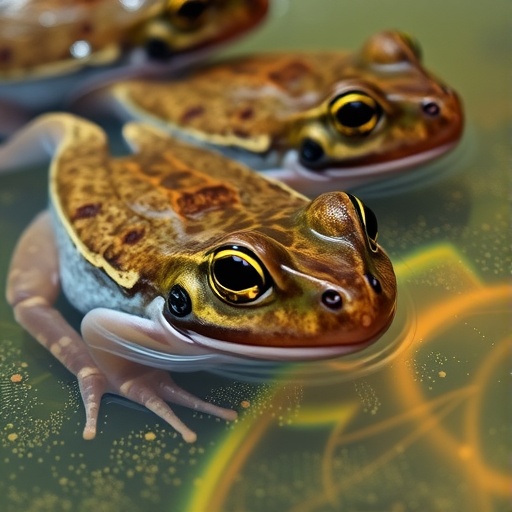In a world increasingly dominated by agricultural practices, the implications of insecticide use are coming under scrutiny, especially concerning their effects on non-target species. A recent study led by Virote et al. explores the oxidative, genotoxic, and histopathological impacts of the insecticide carbofuran on tadpoles of the species Dendropsophus minutus. What emerges from this research is a compelling narrative of how modern agriculture can unwittingly produce ecological consequences, primarily affecting vulnerable wildlife populations such as amphibians.
Carbofuran, a broad-spectrum carbamate insecticide, has been widely used in agricultural settings to manage pest populations. However, its impact extends beyond the intended targets, potentially resulting in harmful repercussions for non-target species within the ecosystem. The study’s authors aimed to reveal how carbofuran exposure affects the health of tadpoles, which are often used as sentinel species to gauge environmental quality.
The research methodology involved exposing Dendropsophus minutus tadpoles to varying concentrations of carbofuran in controlled laboratory settings. Over a specified timeframe, the authors assessed the oxidative stress levels in these amphibians, a critical indicator of cellular damage that can lead to varied pathological outcomes. The use of biomarkers allowed researchers to quantify the extent of oxidative stress with remarkable precision, bringing to light the magnitude of the impact of this insecticide.
One striking outcome of the study was the elevation of reactive oxygen species (ROS) in the bodies of tadpoles exposed to carbofuran. The presence of such compounds is known to initiate a cascade of oxidative damage, impairing cell function and overall organismal health. This form of stress can lead to significant alterations at both cellular and tissue levels, triggering a series of detrimental effects that can compromise the tadpoles’ development, growth, and survival potential in natural habitats.
Genotoxic effects, another key focus of the study, were evaluated through the examination of DNA strand breaks in the exposed tadpoles. The results revealed a stark increase in the frequency of such breaks, indicating that carbofuran possesses formidable genotoxic potential. This revelation poses serious concerns not only for the immediate health of these tadpoles but also for the broader implications regarding population dynamics and genetic variability of amphibians exposed to environmental contaminants.
Histopathological assessments further solidified the alarming findings. Tissue samples collected from the exposed tadpoles showed signs of cellular degeneration, inflammatory responses, and necrosis in critical organs. The histological alterations provided visible confirmation of the toxic effects of carbofuran, revealing a pattern of damage that underscores the fragility of amphibian life stages, particularly during the sensitive tadpole phase.
As the study delves deeper into the implications of these findings, the authors postulate that the impacts of insecticides like carbofuran extend beyond immediate ecological damage. Ecosystem health relies heavily on amphibians, which play pivotal roles in food webs. Their decline could disrupt food resources for higher trophic levels, leading to cascading effects within the ecosystem.
The burgeoning evidence from this research echoes a growing body of literature that underscores the need for reassessing the use of certain agrochemicals in practices that prioritize environmental sustainability. The inherent risk of non-target species experiencing harmful effects from widely used agricultural chemicals raises ethical questions about current practices and necessitates urgent discourse among stakeholders in agriculture, ecology, and conservation biology.
Efforts to regulate or find alternative pest management strategies that mitigate ecological risks have gained traction in recent years. Integrated pest management and organic farming practices are emerging as viable solutions that can balance agricultural productivity with ecological integrity. The findings from Virote et al.’s study serve as critical data supporting calls for such transformations in agricultural paradigms.
In conclusion, the detrimental effects of carbofuran on Dendropsophus minutus tadpoles mirror a larger narrative about humanity’s relationship with nature. As our interactions with ecosystems become more intensive, the collateral damage inflicted on non-target organisms raises significant ethical and ecological concerns. This study serves as a wake-up call, advocating for responsible stewardship of the environment and a reevaluation of how we utilize chemicals in agriculture.
This research not only highlights the immediate effects of insecticides on amphibians but also invites us to reflect on our role in safeguarding biodiversity. As the agricultural sector continues to grapple with the challenges posed by pests, the lessons learned from such studies should inform future practices that seek to harmonize human activity with the natural world.
Let us hope that the alarm raised by this research resonates widely, prompting both policymakers and farmers to reconsider the extensive use of harmful chemicals in favor of practices that protect the intricate tapestry of life that surrounds us.
Subject of Research: The effects of carbofuran insecticide on non-target animals, specifically on Dendropsophus minutus tadpoles.
Article Title: How do insecticides affect non-target animals? The oxidative, genotoxic and histopathological effects of carbofuran in Dendropsophus minutus tadpoles.
Article References:
Virote, A.J.P.P., Sotero, D.F., Freitas, R.M.P. et al. How do insecticides affect non-target animals? The oxidative, genotoxic and histopathological effects of carbofuran in Dendropsophus minutus tadpoles.
Environ Sci Pollut Res (2025). https://doi.org/10.1007/s11356-025-37001-2
Image Credits: AI Generated
DOI: 10.1007/s11356-025-37001-2
Keywords: insecticide, carbofuran, amphibians, oxidative stress, genotoxic effects, histopathology, environmental impact, agriculture, non-target species.




